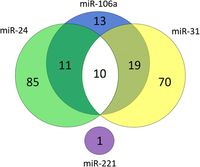ScienceDirect
The regulatory role of microRNAs in the development, cyclic changes, ...
A variety of studies have been evaluated the role of miRNAs in the development and cyclic changes of hair. It is well-documented that miRNAs play a vi…
ScienceDirect
Defining microRNA signatures of hair follicular stem and progenitor ...
Dicer and Drosha-DGCR8, the key components of microRNA biogenesis, were demonstrated to be expressed in the hair follicle (HF). Dicer has an essential role in the morphology and development of the anagen phase of hair. HF cycling is governed by miRNAs that regulate gene activation and silencing.
NCBI
Integrated Hair Follicle Profiles of microRNAs and mRNAs to Reveal ...
More specifically, KRT27, KRT35, and KRT85 were found to be involved in the construction of the initially differentiated cortical structure, which ultimately leads to fibrillar bending [21], while, KRT17 was involved in the regulation of the hair follicle cycle and acted as a positive regulator ...
Frontiers
Frontiers | Morphogenesis, Growth Cycle and Molecular Regulation ...
Dermal Blimp1 Acts Downstream of Epidermal TGFβ and Wnt/β-Catenin to Regulate Hair Follicle Formation and Growth. J. Investigative Dermatology 137 (11), 2270–2281. doi:10.1016/j.jid.2017.06.015 · PubMed Abstract | CrossRef Full Text | Google Scholar · Vishlaghi, N., and Lisse, T. S. (2020).
NCBI
MicroRNA-214 controls skin and hair follicle development by ...
Skin development is governed by complex programs of gene activation and silencing, including microRNA-dependent modulation of gene expression. Here, we show that miR-214 regulates skin morphogenesis and hair follicle (HF) cycling by targeting β-catenin, a key component of the Wnt signaling pathway.
NCBI
Thyroid hormone signaling controls hair follicle stem cell function ...
In mice lacking thyroid hormone receptors, bulge stem cells of the hair follicles present epigenetic alterations and a functional defect in their mobilization out of the niche. This is related to aberrant activation of Smad signaling and reduced nuclear ...
NCBI
MicroRNAs in hair cell development and deafness - PMC
The identification of transcriptional activators and repressors of hair cell fates has recently been augmented by the discovery of microRNAs (miRNAs) that can function as post-transcriptional repressors in sensory hair cells.miRNAs are ~21 nucleotide ...
ScienceDirect
Molecular Mechanisms Regulating Hair Follicle Development - ...
Hair follicles are self-renewing and contain reservoirs of multipotent stem cells that are capable of regenerating the epidermis and are thought to be utilized in wound healing. Hair follicles are also the sites of origin of many neoplasias, including some basal cell carcinomas and pilomatricoma.
Frontiers
Frontiers | The Roles of Non-coding RNA in the Development and ...
Non-coding RNAs (ncRNAs), especially microRNAs and long ncRNAs, have significant modulatory roles in HF development and regeneration via regulation of these signalling pathways. This review provides a comprehensive overview of the status and future prospects of ncRNAs in HF regeneration and ...
Medicalnewstoday
Hair regrowth: Could microRNA lead the way?
August 8, 2020 - A recent study has identified a microRNA that could help reverse hair loss. The findings could lead to more effective, less time-consuming interventions.
Healthline
Promising New Hair Loss Treatment Using MicroRNA May Soon Be Available
June 27, 2023 - “More specifically,” she noted, “miR-205 has been identified as an important microRNA that can potentially stimulate hair growth.” · Green said that RNA (ribonucleic acid) is present in all living cells. It acts as a messenger to carry instructions from our DNA to regulate protein ...
ResearchGate
The regulatory mechanism of microRNAs in skin and hair follicle ...
July 20, 2014 - Request PDF | The regulatory mechanism of microRNAs in skin and hair follicle development | MicroRNAs (miRNAs) are an emerging class of regulators that control post-transcriptional processes, and could be potential targets for drug in... | Find, read and cite all the research you need on ...
Nih
Signaling Involved in Hair Follicle Morphogenesis and Development ...
Hair follicle morphogenesis depends on Wnt, Shh, Notch, BMP and other signaling pathways interplay between epithelial and mesenchymal cells. The Wnt pathway plays an essential role during hair follicle induction, Shh is involved in morphogenesis and ...
Biomedcentral
Expression profiling and bioinformatic analyses suggest new target ...
Background Human hair follicle (HF) cycling is characterised by the tight orchestration and regulation of signalling cascades. Research shows that micro(mi)RNAs are potent regulators of these pathways. However, knowledge of the expression of miRNAs and their target genes and pathways in the ...
Nature
Inhibition of microRNA turns back the CLOCK of hair follicle aging ...
A new study shows that increased microRNA-31 expression is associated with hair follicle aging. Genetic deletion of the microRNA or pharmacological inhibition of its downstream effectors suppresses hair follicle stem cell aging in mice.
PubMed
MicroRNAs (miRNAs) in the control of HF development and cycling: ...
Hair follicle development and its postnatal regeneration are characterized by dramatic changes in its microanatomy and cellular activity, which are controlled by multiple signalling pathways, transcription factors and epigenetic regulators, including microRNAs (miRNAs). miRNAs and their targets ...
Biomedcentral
Integrated analysis of miRNAs and mRNA profiling reveals the ...
Background Merino sheep exhibit high wool production and excellent wool quality. The fleece of Merino sheep is predominantly composed of wool fibers grown from hair follicles (HFs). The HF is a complex biological system involved in a dynamic process governed by gene regulation, and gene expression ...
NCBI
Regulation of signaling pathways in hair follicle stem cells - PMC
Hair follicle stem cells (HFSCs) reside in the bulge region of the outer root sheath of the hair follicle. They are considered slow-cycling cells that are endowed with multilineage differentiation potential and superior proliferative capacity. The normal ...
NC State News
Researchers Identify MicroRNA That Shows Promise for Hair Regrowth ...
Researchers have identified a microRNA that could promote hair regeneration.


